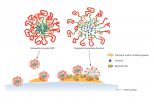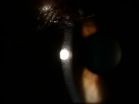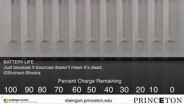A novel way to apply drugs to dental plaque
Nanoparticles release drugs to reduce tooth decay
2015-04-01
(Press-News.org) Therapeutic agents intended to reduce dental plaque and prevent tooth decay are often removed by saliva and the act of swallowing before they can take effect. But a team of researchers has developed a way to keep the drugs from being washed away.
Dental plaque is made up of bacteria enmeshed in a sticky matrix of polymers--a polymeric matrix--that is firmly attached to teeth. The researchers, led by Danielle Benoit at the University of Rochester and Hyun Koo at the University of Pennsylvania's School of Dental Medicine, found a new way to deliver an antibacterial agent within the plaque, despite the presence of saliva.
Their findings have been published in the journal ACS Nano.
"We had two specific challenges," said Benoit, an assistant professor of biomedical engineering. "We had to figure out how to deliver the anti-bacterial agent to the teeth and keep it there, and also how to release the agent into the targeted sites."
To deliver the agent--known as farnesol--to the targeted sites, the researchers created a spherical mass of particles, referred to as a nanoparticle carrier. They constructed the outer layer out of cationic--or positively charged--segments of the polymers. For inside the carrier, they secured the drug with hydrophobic and pH-responsive polymers.
The positively-charged outer layer of the carrier is able to stay in place at the surface of the teeth because the enamel is made up, in part, of HA (hydroxyapatite), which is negatively charged. Just as oppositely charged magnets are attracted to each other, the same is true of the nanoparticles and HA. Because teeth are coated with saliva, the researchers weren't certain the nanoparticles would adhere. But not only did the particles stay in place, they were also able to bind with the polymeric matrix and stick to dental plaque.
Since the nanoparticles could bind both to saliva-coated teeth and within plaque, Benoit and colleagues used them to carry an anti-bacterial agent to the targeted sites. The researchers then needed to figure out how to effectively release the agent into the plaque.
A key trait of the inner carrier material is that it destabilizes at acidic--or low pH--levels, such as 4.5, allowing the drug to escape more rapidly. And that's exactly what happens to the pH level in plaque when it's exposed to glucose, sucrose, starch, and other food products that cause tooth decay. In other words, the nanoparticles release the drug when exposed to cavity-causing eating habits--precisely when it is most needed to quickly stop acid-producing bacteria.
The researchers tested the product in rats that were infected with Streptococcus mutans--a microbe that causes tooth decay. "We applied the test solutions to rats' mouths twice daily for 30 seconds, simulating what a person might do using a mouth rinse morning and night," said Hyun Koo, a professor in the Department of Orthodontics and co-senior author of the work. "When the drug was administered without the nanoparticle carriers, there was no effect on the number of cavities and only a very small reduction in their severity. But when it was delivered by the nanoparticle carriers, both the number and severity of the cavities were reduced."
Plaque formation and tooth decay are chronic conditions that need to be monitored through regular visits to the dental office. The researchers hope their results will someday lead to better--and perhaps permanent--treatments for dental plaque and tooth decay, as well as other biofilm-related diseases.
INFORMATION:
[Attachments] See images for this press release:

ELSE PRESS RELEASES FROM THIS DATE:
2015-04-01
People who apply eyeliner on the inner eyelid run the risk of contaminating the eye and causing vision trouble, according to research by a scientist at the University of Waterloo. This is the first study to prove that particles from pencil eyeliner move into the eye.
Dr. Alison Ng, at the Centre for Contact Lens Research at Waterloo, directed the study when she was at Cardiff University in Wales. The team's findings appear in Eye and Contact Lens Science and Clinical Practice, the official peer-reviewed journal of the Contact Lens Association of Ophthalmologists.
Dr. ...
2015-04-01
If you are trying to have a baby, a good night's sleep is more important than ever. A new research report appearing in The FASEB Journal shows that the womb has its own "body clock" that needs to synchronize with the mother's body clock to ensure optimal conditions for fetal growth and development. The inability of a mother's body clock to synchronize with the womb's clock may be at least part of the reason why some women have difficulty carrying a pregnancy to full term. Specifically, the failed synchronization switches off body clock genes in cells lining the womb, which ...
2015-04-01
ANCHORAGE, Alaska -- A team of scientists led by the U.S. Geological Survey found that polar bears, increasingly forced on shore due to sea ice loss, may be eating terrestrial foods including berries, birds and eggs, but any nutritional gains are limited to a few individuals and likely cannot compensate for lost opportunities to consume their traditional, lipid-rich prey -- ice seals.
"Although some polar bears may eat terrestrial foods, there is no evidence the behavior is widespread," said Dr. Karyn Rode, lead author of the study and scientist with the USGS. "In the ...
2015-04-01
Washington, DC--Night owls are more likely to develop diabetes, metabolic syndrome and sarcopenia than early risers, even when they get the same amount of sleep, according to a new study published in the Endocrine Society's Journal of Clinical Endocrinology & Metabolism.
The study examined the difference between night and morning chronotypes, or a person's natural sleep-wake cycle. Staying awake later at night is likely to cause sleep loss, poor sleep quality, and eating at inappropriate times, which might eventually lead to metabolic change.
"Regardless of lifestyle, ...
2015-04-01
Washington, DC--Exposure to the endocrine-disrupting chemical bisphenol A during pregnancy may raise a mother's susceptibility to weight gain and diabetes later in life, according to a new animal study published in the Endocrine Society's journal Endocrinology.
A chemical used to manufacture plastics and epoxy resins, bisphenol A (BPA) is found in a variety of consumer products, including plastic bottles, food cans and cash register receipts. The U.S. Centers for Disease Control and Prevention have estimated that more than 96 percent of Americans have BPA in their bodies.
BPA ...
2015-04-01
Cambridge, Mass. April 1, 2015-- A collaborative study between researchers from the Broad Institute of MIT and Harvard, Massachusetts Institute of Technology, and the National Center for Biotechnology Information of the National Institutes of Health (NIH-NCBI) has identified a highly efficient Cas9 nuclease that overcomes one of the primary challenges to in vivo genome editing. This finding, published today in Nature, is expected to help make the CRISPR toolbox accessible for in vivo experimental and therapeutic applications.
Originally discovered in bacteria, the CRISPR-Cas9 ...
2015-04-01
Many microbes cannot be cultivated in a laboratory setting, hindering attempts to understand Earth's microbial diversity. Since microbes are heavily involved in, and critically important to environmental processes from nutrient recycling, to carbon processing, to the fertility of topsoils, to the health and growth of plants and forests, accurately characterizing them, as a basis for understanding their activities, is a major goal of the Department of Energy (DOE). One approach has been to study collected DNA extracted from the complex microbial community, or the metagenome, ...
2015-04-01
NEW YORK (April 1, 2015) - Hospitals and health systems preparing for and treating patients with Ebola Virus Disease (EVD) in the fall of 2015 faced unexpected challenges for ensuring safety of staff, patients and the community. The experiences are detailed in two studies published online in Infection Control & Hospital Epidemiology, the journal of the Society for Healthcare Epidemiology of America (SHEA).
In a case study of the care of two patients with confirmed or suspected EVD at the National Institutes of Health (NIH) Clinical Center's Special Clinical Studies Unit, ...
2015-04-01
Mammals are good at figuring out which direction a sound is coming from, whether it's a rabbit with a predator breathing down its neck or a baby crying for its mother. But how we judge how far away that sound is was a mystery until now. Researchers from UConn Health report in the 1 April issue of the Journal of Neuroscience that echoes and fluctuations in volume (amplitude modulation) are the cues we use to figure the distance between us and the source of a noise.
"This opens up a new horizon," says Duck O. Kim, a neuroscientist at UConn Health. Researchers have long ...
2015-04-01
Don't throw away those bouncing batteries.
Researchers at Princeton University have found that common test of bouncing a household battery is not actually an effective way to check a battery's charge.
"The bounce does not tell you whether the battery is dead or not, it just tells you whether the battery is fresh," said Daniel Steingart, an assistant professor of mechanical and aerospace engineering and of the Andlinger Center for Energy and the Environment.
The battery bounce test, popularized in online videos, shows that fully charged batteries bounce very little ...
LAST 30 PRESS RELEASES:
[Press-News.org] A novel way to apply drugs to dental plaque
Nanoparticles release drugs to reduce tooth decay


